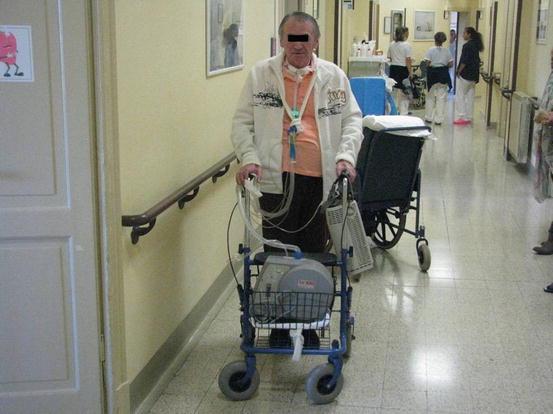Fig. 46.1
Bedside attended session of muscular active training involving the upper limbs

Fig. 46.2
An advanced recovery phase: patient’s flat walking using a rollator but still needing the ventilatory assistance
Patients who survive the acute phase of critical illness experience has a wide range of physical disabilities, including: neuromyopathies with muscle wasting, weakness, and fatigability; joint deformities and contractures; and additional residual disease-related damage to specific organ systems. Patients who remain ventilator-dependent in ICUs may suffer from additional burdens of continuing systemic inflammation and catabolism combined with limited mobility and suboptimal nutrition, and this particularly affects the neuromuscular system. In addition to neuromuscular disorders, patients experience other physical and psychosocial effects, like changes to skin and hair, endocrine impairment, sleep, mood and libido disorders, and chronic pain.
Open visiting hours for family members and comfort among patients and caregivers may be enhanced by return to a more physiologic circadian rhythm as opposed to that found in a typical ICU. Sleep deprivation can have significant consequences and has been shown to impair cognitive function, increase protein catabolism, decrease immune function, and alter respiratory mechanics that might eventually impact weaning from MV. A more “natural environment” like a CVF may minimize the number and intensity of some critical factors involved in the genesis of poor sleep, such as noise and light intensity.
Aspiration is common in patients with tracheostomies receiving prolonged ventilation, and with advanced age the risk of aspiration increases. Swallowing problems are seldom assessed with the appropriate technique (i.e., video fluoroscopy) in the ICU, and the most important specific rehabilitative therapy is rarely started. A less stressed environment than of ICU’s, combining less sedative drugs and more comprehensive teamwork by nurses, respiratory therapists, psychologists, and clergy, typical for a CVF, may improve the patient-clinician relationship. In this view, the expectations and outcomes may be better defined and discussed.
Therefore, organization of a weaning unit requires interaction among different health professionals with specific competence [11]. A medical doctor is generally referred as the most prominent managing figure of the team, often involved in the difficult patient care decision algorithm and in communication with the relatives. Overall, the optimal physician-to-patient ratio in these units is about 1:6. Nurses should assist each patient more than 135 min/day and physiotherapists for 60 min/day or 360 min per week. Other professional figures such as the psychologist and the nutritionist should be involved for at least 10 and 3 h per week, respectively.
46.4 Patient Characteristics in the Weaning Unit
Although advances in intensive care have enabled more patients to survive an acute critical illness, they also have created a large and growing population of chronically critically ill patients with prolonged dependence on MV and other intensive care therapies. The American College of Critical Care Medicine states in its guidelines for admission to and discharge from adult intermediate-care units that “medically stable ventilator patients for weaning and chronic care” are the ideal candidates for these environments. The hallmark of chronic critical illness is respiratory failure requiring prolonged dependence on MV. Besides prolonged ventilator dependence, evidences point out that chronic critical illness is a syndrome comprising additional characteristic features. These include profound weakness attributed to myopathy, neuropathy, and alterations of body composition including loss of lean body mass, increased adiposity, and anasarca; distinctive neuroendocrine changes including loss of pulsatile secretion of anterior pituitary hormones, contributing to low target organ hormone levels and impaired anabolism; increased vulnerability to infection, often with multiresistant microbial organisms; brain dysfunction manifesting as coma or delirium that is protracted or permanent; skin lesions and breakdown; all associated with nutritional deficiencies, edema, urinary incontinence, and prolonged immobility. Patients report significant distress from symptoms like pain, thirst, dyspnea, depression, and anxiety, and from inability to communicate during endotracheal intubation [12]. Chronic critical illness is uniquely characterized by the presence of these features as a clinical constellation in association with prolonged dependence on MV. Between 5 and 10 % of patients who require MV for acute conditions develop chronic critical illness. Between 30 and 53 % of chronically critically ill patients are liberated from MV in the acute-care hospital. Better outcomes are reported by some SWUs, but they often select patients with higher potential for ventilator liberation and rehabilitation. Reimbursement incentives discourage some weaning facilities from admitting patients who have severe irreversible pulmonary processes, require hemodialysis, or have profound neurologic injuries with invariably high mortality rate over 3 months [13]; however, there are more outcomes for the best candidates with such facilities.
Overall, ideal patients are those with respiratory, cardiologic, and neuromuscular diseases referred from general ICUs after failing weaning attempts (see above) and prolonged stay. They are usually tracheostomized and need time to recover their vital functions. Patients with multiorgan failure, extracorporeal supporting devices other than ventilators (i.e., dialysis), or with life expectancy below 15 days are not likely to be successfully managed in the SWUs.
Stay updated, free articles. Join our Telegram channel

Full access? Get Clinical Tree



